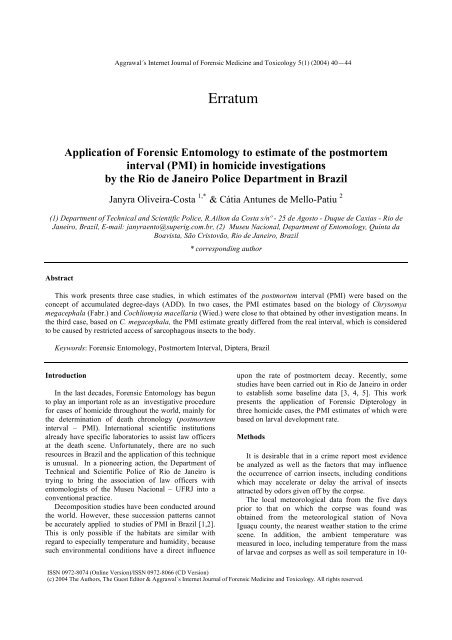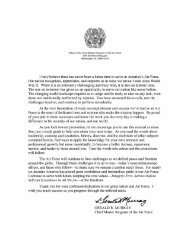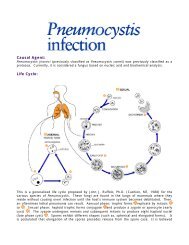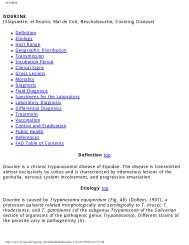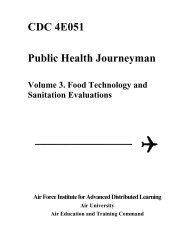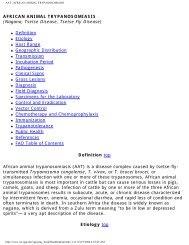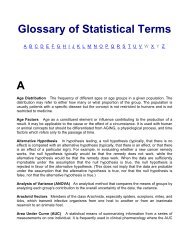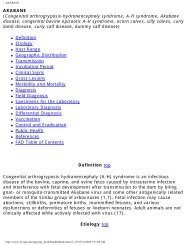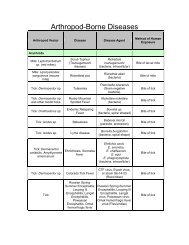Application of Forensic Entomology to estimate of the postmortem ...
Application of Forensic Entomology to estimate of the postmortem ...
Application of Forensic Entomology to estimate of the postmortem ...
Create successful ePaper yourself
Turn your PDF publications into a flip-book with our unique Google optimized e-Paper software.
Aggrawal´s Internet Journal <strong>of</strong> <strong>Forensic</strong> Medicine and Toxicology 5(1) (2004) 40—44<br />
Erratum<br />
<strong>Application</strong> <strong>of</strong> <strong>Forensic</strong> <strong>En<strong>to</strong>mology</strong> <strong>to</strong> <strong>estimate</strong> <strong>of</strong> <strong>the</strong> <strong>postmortem</strong><br />
interval (PMI) in homicide investigations<br />
by <strong>the</strong> Rio de Janeiro Police Department in Brazil<br />
Janyra Oliveira-Costa 1,* & Cátia Antunes de Mello-Patiu 2<br />
(1) Department <strong>of</strong> Technical and Scientific Police, R.Ail<strong>to</strong>n da Costa s/nº - 25 de Agos<strong>to</strong> - Duque de Caxias - Rio de<br />
Janeiro, Brazil, E-mail: janyraen<strong>to</strong>@superig.com.br, (2) Museu Nacional, Department <strong>of</strong> <strong>En<strong>to</strong>mology</strong>, Quinta da<br />
Boavista, São Cris<strong>to</strong>vão, Rio de Janeiro, Brazil<br />
* corresponding author<br />
Abstract<br />
This work presents three case studies, in which <strong>estimate</strong>s <strong>of</strong> <strong>the</strong> <strong>postmortem</strong> interval (PMI) were based on <strong>the</strong><br />
concept <strong>of</strong> accumulated degree-days (ADD). In two cases, <strong>the</strong> PMI <strong>estimate</strong>s based on <strong>the</strong> biology <strong>of</strong> Chrysomya<br />
megacephala (Fabr.) and Cochliomyia macellaria (Wied.) were close <strong>to</strong> that obtained by o<strong>the</strong>r investigation means. In<br />
<strong>the</strong> third case, based on C. megacephala, <strong>the</strong> PMI <strong>estimate</strong> greatly differed from <strong>the</strong> real interval, which is considered<br />
<strong>to</strong> be caused by restricted access <strong>of</strong> sarcophagous insects <strong>to</strong> <strong>the</strong> body.<br />
Keywords: <strong>Forensic</strong> <strong>En<strong>to</strong>mology</strong>, Postmortem Interval, Diptera, Brazil<br />
Introduction<br />
In <strong>the</strong> last decades, <strong>Forensic</strong> <strong>En<strong>to</strong>mology</strong> has begun<br />
<strong>to</strong> play an important role as an investigative procedure<br />
for cases <strong>of</strong> homicide throughout <strong>the</strong> world, mainly for<br />
<strong>the</strong> determination <strong>of</strong> death chronology (<strong>postmortem</strong><br />
interval – PMI). International scientific institutions<br />
already have specific labora<strong>to</strong>ries <strong>to</strong> assist law <strong>of</strong>ficers<br />
at <strong>the</strong> death scene. Unfortunately, <strong>the</strong>re are no such<br />
resources in Brazil and <strong>the</strong> application <strong>of</strong> this technique<br />
is unusual. In a pioneering action, <strong>the</strong> Department <strong>of</strong><br />
Technical and Scientific Police <strong>of</strong> Rio de Janeiro is<br />
trying <strong>to</strong> bring <strong>the</strong> association <strong>of</strong> law <strong>of</strong>ficers with<br />
en<strong>to</strong>mologists <strong>of</strong> <strong>the</strong> Museu Nacional – UFRJ in<strong>to</strong> a<br />
conventional practice.<br />
Decomposition studies have been conducted around<br />
<strong>the</strong> world. However, <strong>the</strong>se succession patterns cannot<br />
be accurately applied <strong>to</strong> studies <strong>of</strong> PMI in Brazil [1,2].<br />
This is only possible if <strong>the</strong> habitats are similar with<br />
regard <strong>to</strong> especially temperature and humidity, because<br />
such environmental conditions have a direct influence<br />
upon <strong>the</strong> rate <strong>of</strong> <strong>postmortem</strong> decay. Recently, some<br />
studies have been carried out in Rio de Janeiro in order<br />
<strong>to</strong> establish some baseline data [3, 4, 5]. This work<br />
presents <strong>the</strong> application <strong>of</strong> <strong>Forensic</strong> Dipterology in<br />
three homicide cases, <strong>the</strong> PMI <strong>estimate</strong>s <strong>of</strong> which were<br />
based on larval development rate.<br />
Methods<br />
It is desirable that in a crime report most evidence<br />
be analyzed as well as <strong>the</strong> fac<strong>to</strong>rs that may influence<br />
<strong>the</strong> occurrence <strong>of</strong> carrion insects, including conditions<br />
which may accelerate or delay <strong>the</strong> arrival <strong>of</strong> insects<br />
attracted by odors given <strong>of</strong>f by <strong>the</strong> corpse.<br />
The local meteorological data from <strong>the</strong> five days<br />
prior <strong>to</strong> that on which <strong>the</strong> corpse was found was<br />
obtained from <strong>the</strong> meteorological station <strong>of</strong> Nova<br />
Iguaçu county, <strong>the</strong> nearest wea<strong>the</strong>r station <strong>to</strong> <strong>the</strong> crime<br />
scene. In addition, <strong>the</strong> ambient temperature was<br />
measured in loco, including temperature from <strong>the</strong> mass<br />
<strong>of</strong> larvae and corpses as well as soil temperature in 10-<br />
ISSN 0972-8074 (Online Version)/ISSN 0972-8066 (CD Version)<br />
(c) 2004 The Authors, The Guest Edi<strong>to</strong>r & Aggrawal´s Internet Journal <strong>of</strong> <strong>Forensic</strong> Medicine and Toxicology. All rights reserved.
Source Stage Thresold Min. Environ. Temp. (ºC) Develop. Time (h) Exp.ADH Exp. ADD<br />
(ºC)<br />
Wells & Kurahashi. Egg hatch 10 27<br />
18 306 12.75<br />
(1994)<br />
1 st moult 30 510 21.25<br />
2 nd moult 72 1224 51<br />
Pupariation 144 2448 102<br />
Emergence<br />
234 3978 165.75<br />
Tab. 1. The time <strong>of</strong> development obtained from literature and expected accumulated degree-hours (ADH) and<br />
degree-days (ADD) <strong>to</strong> Chrysomya megacephala.<br />
20 cm depth, in order <strong>to</strong> relate <strong>the</strong> meteorological data<br />
from <strong>the</strong> nearest wea<strong>the</strong>r station <strong>to</strong> <strong>the</strong> microclimate <strong>of</strong><br />
<strong>the</strong> place <strong>of</strong> <strong>the</strong> crime.<br />
The methods used in this work were based on <strong>the</strong><br />
adaptation <strong>of</strong> methodologies for collection,<br />
transportation and rearing <strong>of</strong> <strong>the</strong> Diptera specimens<br />
described by various authors [6,7,8].<br />
The stage <strong>of</strong> decomposition <strong>of</strong> <strong>the</strong> corpse was<br />
specified according <strong>to</strong> <strong>the</strong> morphological characteristics<br />
observed when it was found (fresh, bloated, early<br />
decomposition, advanced decomposition and remains)<br />
and <strong>the</strong> accuracy <strong>of</strong> PMI <strong>estimate</strong> was evaluated by<br />
reference <strong>to</strong> <strong>the</strong> statements from witnesses.<br />
Adult insects were collected with <strong>the</strong> aid <strong>of</strong> a<br />
modified en<strong>to</strong>mological net [9] and transported in <strong>the</strong><br />
same plastic bag that was coupled <strong>to</strong> <strong>the</strong> net. This<br />
avoids contact <strong>of</strong> <strong>the</strong> collec<strong>to</strong>r with <strong>the</strong> insects,<br />
safeguarding his/her health. Eggs and larvae were<br />
collected from <strong>the</strong> corpses with <strong>the</strong> aid <strong>of</strong> forceps and<br />
brushes, and <strong>the</strong> living specimens were put in jars with<br />
moistened filter paper for <strong>the</strong> eggs and ground bovine<br />
meat for <strong>the</strong> larvae. The jars were closed with gauze <strong>to</strong><br />
allow proper ventilation. Wandering larvae and pupae<br />
were also sought in <strong>the</strong> area around <strong>the</strong> corpse and<br />
taken <strong>to</strong> <strong>the</strong> lab in pots with a little sample <strong>of</strong> soil from<br />
<strong>the</strong> place. All <strong>the</strong> jars were labeled, indicating hour,<br />
date and environmental data.<br />
In <strong>the</strong> labora<strong>to</strong>ry, <strong>the</strong> immature insects were sorted<br />
by instar and morphological similarity and transferred<br />
<strong>to</strong> separate rearing jars. Adult insects collected at <strong>the</strong><br />
crime site as well as those reared in <strong>the</strong> lab were killed<br />
by freezing. Later, <strong>the</strong>y were identified <strong>to</strong> species.<br />
Temperature is <strong>the</strong> most important fac<strong>to</strong>r affecting<br />
<strong>the</strong> growth and development rate <strong>of</strong> insects. The<br />
metabolic heat generated by maggot-mass can be<br />
sufficient <strong>to</strong> raise <strong>the</strong>ir micro-environmental<br />
temperature by several degrees above ambient [10] so it<br />
is essential <strong>to</strong> take in<strong>to</strong> consideration <strong>the</strong> maggot mass<br />
temperature in determining insect development,<br />
specifically for last instar maggots. Consequently,<br />
ambient temperature was used <strong>to</strong> determine<br />
development time for earlier stages, maggot-mass<br />
temperature for later instars and soil temperature for<br />
pupae. A common approach is <strong>to</strong> use maggot-mass<br />
temperature as a constant which would provide <strong>the</strong><br />
fastest growth <strong>of</strong> maggots (around 90 <strong>to</strong> 95º F or 32 <strong>to</strong><br />
35º C) [11].<br />
As hourly temperatures were not available, <strong>the</strong> data<br />
were limited <strong>to</strong> daily maximum and minimum<br />
temperatures used <strong>to</strong> calculate <strong>the</strong> daily mean<br />
temperature. So, PMI <strong>estimate</strong>s had <strong>to</strong> be based on<br />
accumulated degree-day (ADD) units. The calculation<br />
used for ADD was based upon a standard technique<br />
called <strong>the</strong> rectangle method [12]. The heat<br />
accumulation is <strong>the</strong> difference between <strong>the</strong> average<br />
temperature and <strong>the</strong> lower threshold times <strong>the</strong> days<br />
taken <strong>to</strong> develop [13]. Calculations without an<br />
appropriate threshold will over<strong>estimate</strong> <strong>the</strong> heat<br />
accumulation or degree-days. The equation used <strong>to</strong><br />
calculate degree-days per day is:<br />
Degree-days =<br />
(Max. temp. + min. temp.) - (lower threshold) x 1 day<br />
2<br />
This method ignores <strong>the</strong> upper threshold<br />
temperature because <strong>the</strong> highest temperatures rarely<br />
reaches levels where <strong>the</strong>y may have any lethal effect.<br />
Determining <strong>the</strong> lower developmental threshold is an<br />
important prerequisite <strong>to</strong> use <strong>the</strong> degree-day concept.<br />
For <strong>the</strong> two species encountered in <strong>the</strong> present paper, a<br />
lower threshold <strong>of</strong> 10º C was applied [11].<br />
The development data (time and temperature) were<br />
obtained from literature for calculation <strong>of</strong> <strong>the</strong> ADD<br />
required for <strong>the</strong> involved species [14, 15]. The<br />
equation used <strong>to</strong> calculate degree-days per day from<br />
literature (ADD expected) is:<br />
ADD expected =<br />
(temp. – lower threshold.) x hours <strong>of</strong> development<br />
24<br />
For an <strong>estimate</strong> <strong>of</strong> <strong>the</strong> time elapsed since oviposition<br />
and, consequently, <strong>the</strong> minimum PMI, it is important <strong>to</strong><br />
use <strong>the</strong> insect development in backtracking from <strong>the</strong><br />
oldest instar collected <strong>to</strong> <strong>the</strong> time <strong>of</strong> oviposition [11].<br />
Expected ADD was obtained from <strong>the</strong> literature for<br />
each instar (egg, larvae or pupae) and subtracted from<br />
each computed degree-day until <strong>the</strong> beginning<br />
(oviposition).
Case studies<br />
Case study 1<br />
By <strong>the</strong> morning <strong>of</strong> July 6, 1999, <strong>the</strong> remains <strong>of</strong> a<br />
woman were discovered in a residential property. The<br />
doors and windows were shut and <strong>the</strong> corpse was found<br />
covered with varied blankets (Fig. 1). Local<br />
environmental temperature was measured at 26º C,<br />
which was coherent with daily maximum and<br />
minimum temperature (27º C and 15º C respectively)<br />
obtained from <strong>the</strong> wea<strong>the</strong>r station. The body was in a<br />
bloated, partially decomposed state. The abdomen was<br />
bloated and its skin greenish-brown colored. The rigor<br />
mortis was generalized and lividity was fixed. The<br />
report <strong>of</strong> <strong>the</strong> investigation indicated that <strong>the</strong> woman had<br />
been seen alive three days before finding <strong>the</strong> body. In<br />
spite <strong>of</strong> <strong>the</strong>se observations, just some eggs were located<br />
behind <strong>the</strong> ear and <strong>the</strong>y hatched out in labora<strong>to</strong>ry.<br />
These maggots were reared <strong>to</strong> adults. On July 16, after<br />
240 hours, some specimens <strong>of</strong> Chrysomya<br />
megacephala emerged. The expected accumulated<br />
degree-day (Exp. ADD) was figured out as 12.75<br />
basing on <strong>the</strong> time <strong>of</strong> development determined for this<br />
species under labora<strong>to</strong>ry conditions [14], as 18 hours at<br />
27º C (Table 1). Considering that <strong>the</strong> expected ADD<br />
was calculated for egg hatch, but only eggs had been<br />
collected and that oviposition frequently occurs more<br />
than 12 hours after death, as Lo<strong>the</strong> [16] observed <strong>to</strong> C.<br />
albiceps and C. chloropyga and Oliveira-Costa [3] <strong>to</strong><br />
species collected in this search, <strong>the</strong> PMI came <strong>to</strong><br />
slightly more than 1 day (Table 2). This result has not<br />
corroborated <strong>the</strong> <strong>estimate</strong> obtained by <strong>the</strong> usual<br />
<strong>Forensic</strong> Medicine methods (physical appearance <strong>of</strong> <strong>the</strong><br />
body, lividity, rigor mortis and mainly by investigation<br />
report or witness’ statement). Probably, <strong>the</strong> delay in<br />
flies locating and ovipositing on <strong>the</strong> corpse derives<br />
from <strong>the</strong> fact that <strong>the</strong> doors and windows were shut and<br />
<strong>the</strong> corpse was found covered with blankets, creating a<br />
barrier and hindering <strong>the</strong> access <strong>of</strong> insects <strong>to</strong> <strong>the</strong><br />
remains as well as <strong>the</strong> release <strong>of</strong> attractive odours.<br />
DAY<br />
Soil<br />
temp.<br />
Environ. Temp.<br />
Max. Temp.<br />
Min. Temp.<br />
maggot<br />
mass<br />
temp.<br />
DD-<br />
B10<br />
ADD-<br />
B10<br />
July 6 27º C 15º C 11 12.75<br />
Tab. 2. Case 1: Calculation <strong>of</strong> <strong>the</strong> degree-day (DD)<br />
and accumulated degree-days (ADD) with lower<br />
threshold temperature <strong>of</strong> 10º C.<br />
Day<br />
soil<br />
temp.<br />
Environ. Temp.<br />
maggot<br />
mass<br />
temp.<br />
DD-<br />
B10<br />
ADD-<br />
B10<br />
Max.<br />
Temp.<br />
Min.<br />
Temp.<br />
July 6 32º C 22 51<br />
July 5 25º C 16º C 10.5 29<br />
July 4 26º C 19º C 12.5 18.5<br />
July 3 25º C 13º C 9 6.5<br />
Tab. 3. Case 2: Calculation <strong>of</strong> <strong>the</strong> degree-day (DD)<br />
and accumulated degree-days (ADD) with lower<br />
threshold temperature <strong>of</strong> 10º C.<br />
Source Stage Thresold<br />
Min. (ºC)<br />
Byrd &<br />
Butler<br />
(1996)<br />
Environ.<br />
Temp.<br />
(ºC)<br />
Develop.<br />
Time (h)<br />
Exp.A<br />
DH<br />
Exp.<br />
ADD<br />
Egg 10 25 12 180 7.5<br />
1 st instar 18 270 11.25<br />
2 nd instar 24 360 15<br />
3 rd instar 62 930 38.75<br />
Pupation 116 1740 72.5<br />
Pupa 124 1860 77.5<br />
Adult<br />
240 3600 150<br />
Tab. 4. The time <strong>of</strong> development obtained from<br />
literature and expected accumulated degree-hours<br />
(ADH) and degree-days (ADD) <strong>to</strong> Cochliomyia<br />
macellaria.<br />
Day<br />
Soil<br />
temp.<br />
Environ. Temp.<br />
maggot<br />
mass<br />
temp.<br />
DD-<br />
B10<br />
ADD-<br />
B10<br />
Max.<br />
Temp.<br />
Min.<br />
Temp.<br />
August 9 25º C 15 77.5<br />
August 8 32º C 22 62.5<br />
August 7 32º C 22 40.5<br />
August 6 26º C 18º C 12 17.5<br />
August 5 28º C 20º C 14 5.5<br />
Tab. 5. Case 3: Calculation <strong>of</strong> <strong>the</strong> degree-day (DD)<br />
and accumulated degree-days (ADD) with lower<br />
threshold temperature <strong>of</strong> 10º C.<br />
Case study 2<br />
On July 06, 1999, in <strong>the</strong> morning, <strong>the</strong> corpse <strong>of</strong> a<br />
man in a bloated stage <strong>of</strong> decomposition was<br />
discovered in a vacant lot with an ear<strong>the</strong>n floor covered<br />
by low vegetation (Fig. 2). The abdomen’s skin was<br />
colored greenish-brown and it was bloated. The rigor<br />
mortis was generalized and lividity was fixed.<br />
Environmental temperature was measured <strong>to</strong> 27º C,<br />
which was coherent with daily minimum and maximum<br />
temperature (27º C and 15º C respectively) obtained<br />
from <strong>the</strong> wea<strong>the</strong>r station. The investigation report<br />
indicated that <strong>the</strong> man had been seen alive four days<br />
before finding <strong>the</strong> body. The investigation indicated <strong>the</strong><br />
authorship ratifying <strong>the</strong> date <strong>of</strong> death. Adult specimens<br />
<strong>of</strong> Chrysomya megacephala, Cochliomyia macellaria<br />
and Sarcophaga (Liopygia) ruficornis (Fabr.) were<br />
present. As for immature stages, a lot <strong>of</strong> third instar<br />
larvae were found, especially in <strong>the</strong> cranial area.
Maggot-mass temperature was measured at 32º C. On<br />
July 14, after 141 hours, some specimens <strong>of</strong> Chrysomya<br />
megacephala emerged. Considering that oviposition<br />
frequently occurs more than 12 hours after death [3,<br />
16], <strong>the</strong> accumulated degree-days (ADD) were<br />
calculated and <strong>the</strong> <strong>estimate</strong> <strong>of</strong> minimum <strong>postmortem</strong><br />
interval was 4,5 days based on <strong>the</strong> time <strong>of</strong> development<br />
determined for <strong>the</strong> 2nd moult <strong>of</strong> this species under<br />
labora<strong>to</strong>ry conditions as 72 hours at 27º C [14] (Table<br />
1), corroborating <strong>the</strong> interval obtained by <strong>the</strong> traditional<br />
method (Table 3).<br />
Case study 3<br />
In <strong>the</strong> morning <strong>of</strong> August 9, 1999, <strong>the</strong> corpse <strong>of</strong> a man<br />
was discovered in a mixed forest (Fig. 3), <strong>the</strong> local<br />
environmental temperature was 27º C and soil<br />
temperature was 25º C. The investigation report<br />
pointed out that <strong>the</strong> man had been seen alive six days<br />
before finding <strong>the</strong> body. The body was in an early<br />
decomposition stage and adult specimens <strong>of</strong><br />
Calliphoridae and Sarcophagidae were present. As for<br />
immature stages, a lot <strong>of</strong> third instar larvae were found<br />
on <strong>the</strong> corpse and dark puparia were found in <strong>the</strong> soil<br />
near <strong>the</strong> body. On August 13, after 92 hours, some<br />
specimens <strong>of</strong> Cochliomyia macellaria emerged. The<br />
expected ADD was based on <strong>the</strong> time <strong>of</strong> development<br />
determined for pupation <strong>of</strong> this species under labora<strong>to</strong>ry<br />
conditions as 116 hours at 25º C [15] (Table 4). As<br />
puparia were already dark, <strong>the</strong>y had developed for at<br />
least 24 hours subject <strong>to</strong> <strong>the</strong> soil heat (Table 5).<br />
Considering that oviposition frequently occurs more<br />
than 12 hours after death [3, 16], <strong>the</strong> <strong>estimate</strong> <strong>of</strong><br />
<strong>postmortem</strong> interval for this case was 5.5 days, <strong>the</strong>reby<br />
confirming <strong>the</strong> interval indicated by <strong>the</strong> investigation<br />
report.<br />
Discussion<br />
Fig. 1-3. Bodies <strong>of</strong> victims at <strong>the</strong> scene where <strong>the</strong>y were<br />
discovered: Case 1 (<strong>to</strong>p), Case 2 (middle), Case 3<br />
(bot<strong>to</strong>m).<br />
The <strong>estimate</strong> <strong>of</strong> <strong>postmortem</strong> interval based on<br />
en<strong>to</strong>mological evidence was in agreement with <strong>the</strong> PMI<br />
obtained by standard means, provided that all evidence<br />
from <strong>the</strong> death scene is taken in<strong>to</strong> consideration, such<br />
as <strong>the</strong> delayed arrival <strong>of</strong> flies <strong>to</strong> a corpse when in<br />
enclosed environments. The <strong>estimate</strong> <strong>of</strong> PMI can be<br />
different from <strong>the</strong> real interval due <strong>to</strong> physical<br />
circumstances in <strong>the</strong> surroundings <strong>of</strong> <strong>the</strong> remains [17].<br />
The application <strong>of</strong> <strong>the</strong> en<strong>to</strong>mological method requires<br />
extensive knowledge <strong>of</strong> <strong>the</strong> mechanical and<br />
environmental fac<strong>to</strong>rs that can interfere with <strong>the</strong><br />
processes <strong>of</strong> colonization, <strong>the</strong> development time and<br />
<strong>the</strong> decomposition <strong>of</strong> <strong>the</strong> corpses by insects.<br />
The forensic en<strong>to</strong>mologist has <strong>to</strong> do careful<br />
measurements <strong>of</strong> <strong>the</strong> temperature which <strong>the</strong> immature<br />
insect was submitted <strong>to</strong>, in order <strong>to</strong> determine which<br />
temperature should be used for obtaining a more<br />
precise calculation.<br />
Lamentably, in Brazil, <strong>the</strong>re is little collaboration<br />
between en<strong>to</strong>mologists and law <strong>of</strong>ficers. Only few<br />
<strong>of</strong>ficers have a basic training in en<strong>to</strong>mology.<br />
Therefore, this study is pioneering, and <strong>the</strong> usefulness<br />
<strong>of</strong> this method depends on how <strong>the</strong> corpse is processed<br />
before <strong>the</strong> en<strong>to</strong>mological analytical methods can be<br />
applied. As o<strong>the</strong>r authors have already stated [18],<br />
ideally, <strong>the</strong> team <strong>of</strong> pr<strong>of</strong>essionals who are first called <strong>to</strong><br />
<strong>the</strong> death scene or <strong>the</strong> au<strong>to</strong>psy should comprise a<br />
forensic en<strong>to</strong>mologist.<br />
Acknowledgments<br />
Thanks <strong>to</strong> Dr. Thomas Pape for his useful comments<br />
on <strong>the</strong> manuscript.
References<br />
[1] M. Benecke. Use <strong>of</strong> forensic en<strong>to</strong>mology in cases<br />
concerning putrefied corpses. Arch. Kriminol. 198<br />
(1996) 99-109.<br />
[2] J. B. Davis, L. G<strong>of</strong>f. Decomposition patterns in<br />
terrestrial and intertidal habitats on Oahu island and<br />
Coconut island, Hawaii. J. <strong>Forensic</strong> Sci. 45 (2000) 836-<br />
842.<br />
[3] J. Oliveira-Costa. Dipter<strong>of</strong>auna cadavérica dos<br />
municípios de Duque de Caxias e São João de<br />
Meriti.[dissertation]. Univ. Federal do Rio de Janeiro,<br />
Rio de Janeiro. 2000.<br />
[4] J. Oliveira-Costa, C. A. Mello-Patiu, S. M. Lopes.<br />
Dípteros muscóides associados com cadáveres humanos<br />
na cena da morte no estado do Rio de Janeiro, Brasil.<br />
Bol. Mus. Nac. - série Zool. 464 (2001a) 1-6.<br />
[5] J. Oliveira-Costa, C. A. Mello-Patiu, S. M. Lopes. A<br />
influência de diferentes fa<strong>to</strong>res na freqüência de dípteros<br />
muscóides em cadáveres humanos no Rio de Janeiro.<br />
Bol. Mus. Nac. - série Zool. 470 (2001b) 1-10<br />
[6] W. D. Lord, J. F. Burger. Collection and preservation <strong>of</strong><br />
forensically important en<strong>to</strong>mological materials. J.<br />
<strong>Forensic</strong> Sci. 28 (1983) 936–944.<br />
[7] K. G. V. Smith. A manual <strong>of</strong> forensic en<strong>to</strong>mology.<br />
British Museum, Natural His<strong>to</strong>ry, London, 1986.<br />
[8] E. P. Catts; N. H. Haskell <strong>En<strong>to</strong>mology</strong> and death: a<br />
procedural guide. Clemson: Joyce’s Print Shop,<br />
Clemson, 1991.<br />
[9] A. Khouri. Notas sobre a confecção de uma rede de<br />
coleta e armadilha especialmente para Dípteros<br />
caliptra<strong>to</strong>s em lixo. Bol. Mus. Ent. Univ. Valle 3 (1995)<br />
55–59.<br />
[10] E. P. Catts, L G<strong>of</strong>f. <strong>Forensic</strong> en<strong>to</strong>mology in criminal<br />
investigations. Ann. Rev. En<strong>to</strong>mol. 37 (1992) 253-272.<br />
[11] L. G. Higley, N. H. Haskell. Insect development and<br />
forensic en<strong>to</strong>mology, in: J. A. Byrd, J. L. Castner (Eds.),<br />
<strong>Forensic</strong> <strong>En<strong>to</strong>mology</strong>: <strong>the</strong> utility <strong>of</strong> arthropods in<br />
investigations, CRC Press, Boca Ra<strong>to</strong>n, 2001, pp. 287-<br />
302.<br />
[12] C. Y. Arnold. Maximum and minimum temperatures as<br />
a basis for computing heat units. Proc. Am. Soc.<br />
Horticult. Sci. 74 (1960) 430-445.<br />
[13] L. T. Wilson, W. W. Barnett. Degree-days an aid in crop<br />
and pest management. California Agric. Jan/Feb (1983)<br />
4-7.<br />
[14] J. D. Wells, H. Kurahashi. Chysomya megacephala<br />
(Fabricius) (Diptera: Callipohoridae) development: rate,<br />
variation and implications for forensic en<strong>to</strong>mology.<br />
Japn. J. San. Zool. 45 (1994) 303-309.<br />
[15] J. Byrd, J. F. Butler. Effects <strong>of</strong> temperature on<br />
Cochliomyia macellaria (Diptera:Calliphoridae)<br />
development. J. Med. En<strong>to</strong>mol. 33 (1996) 901-905.<br />
[16] F. Lo<strong>the</strong>. The use <strong>of</strong> larval infestation in determining<br />
time <strong>of</strong> death. Med. Sci. Law 4 (1964) 113-115.<br />
[17] L. G<strong>of</strong>f, B. C. Odom. <strong>Forensic</strong> <strong>En<strong>to</strong>mology</strong> in <strong>the</strong><br />
Hawaiian Islands. Am. J. Forens. Med. Path. 8 (1987)<br />
45-50.<br />
[18] K. Schoenly, K. Griest, S. Rhine. An experimental field<br />
pro<strong>to</strong>col for investigating <strong>the</strong> <strong>postmortem</strong> interval using<br />
multidisciplinary indica<strong>to</strong>rs. J. <strong>Forensic</strong> Sci. 36 (1991)<br />
1395–1415.


